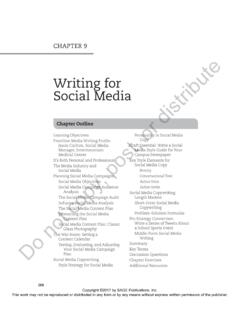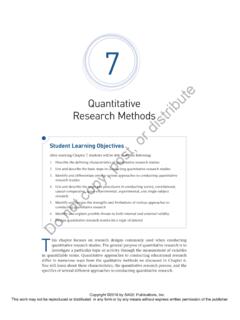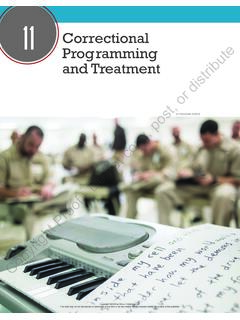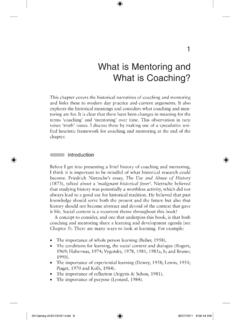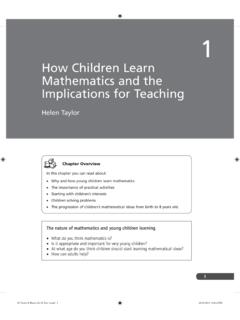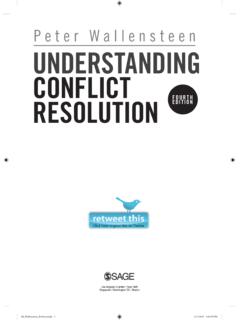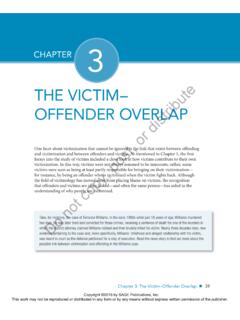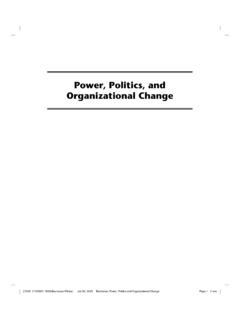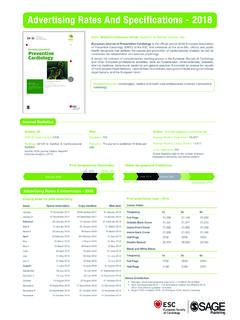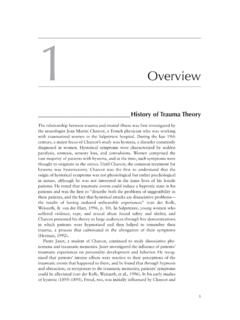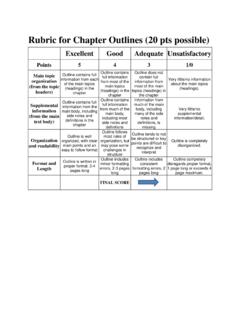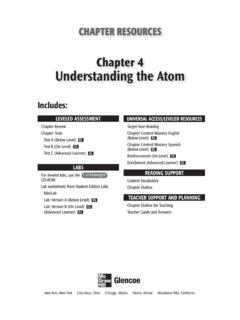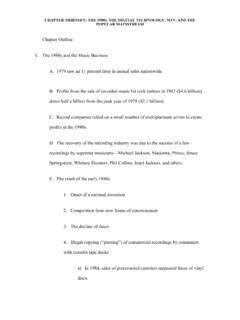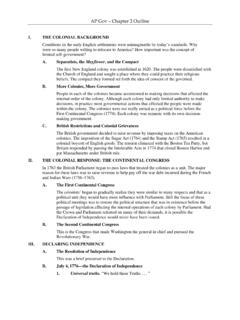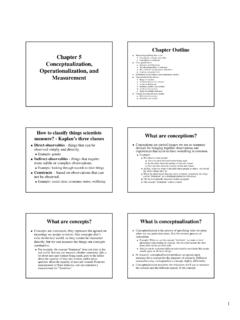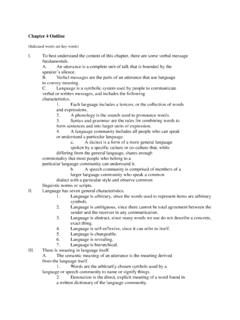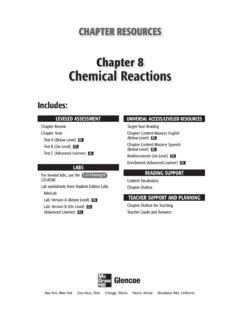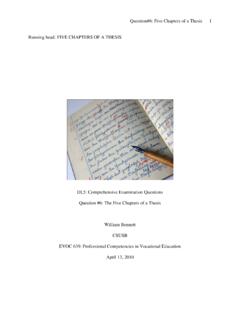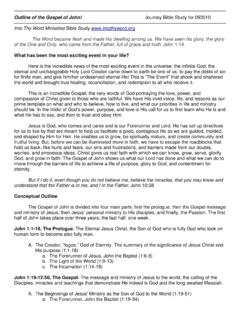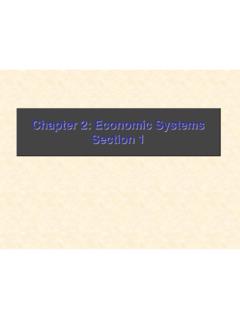Transcription of CHAPTER OUTLINE - SAGE Publications
1 55 Creative Forms ofCommunicatingand ReportingTopics Discussed Photographs Cartoons Poetry DramaQuestions to Ponder What are the benefits of using creative formats to communicate andreport evaluation findings? When is it most appropriate to use different creative forms of commu-nicating and reporting? How might creative approaches be used in conjunction with moretraditional communicating and reporting formats?Creative forms of communicating and reporting, including photo-graphy, cartoons, poetry, and drama, are increasingly being used byevaluators to present evaluation findings to a variety of audiences (inaddition to the case examples provided in this CHAPTER , see Brady, 2000;221 CHAPTERCHAPTER 11/22/2004 3:52 PM Page 221 Denzin, 2000; Greene, 2001; Harper, 2000; McCall, 2000; Richardson,2000). Creative formats facilitate personalized representation and interpre-tation of evaluation findings on many levels.
2 First, photography, cartoons,poetry, and drama are particularly good at capturing multiple voices, allow-ing program participants to do their own talking (Denzin, 1994, p. 503),and allowing the world being described to speak for itself (p. 507).Second, evaluators perspectives are represented through their data analysesand presentations of the findings (often developed in collaboration withstakeholders). Third, each person who then views the photographs or car-toons, reads the poems, or participates as an audience member of a dramaticperformance creates his or her own meaning and interpretations as theperson engages in the dialogue, reflection, and visual, oral, and kinestheticstimulations these formats encourage (Altheide & Johnson, 1994).Photographs, cartoons, poetry, and dramatic performances are particularlyuseful for communicating tacit knowledge, including insights, apprehensions,hunches, impressions, and feeling (Guba & Lincoln, 1982).
3 Photographycanhelp convey the context of an evaluand, and/or reveal aspects of implementationor outcomes that might otherwise be overlooked by traditional data collectionmethods. It can help cross language barriers that may inhibit participants ability to express their opinions or assimilate written simple or symbolically complex issues in an accessibleand concise format. The message(s) or theme(s) of evaluation findings can beconveyed via cartoons in the same way that political cartoons are used toreveal the perspective or viewpoint of their creator. Cartoons can also conveyevaluation information to audiences with low reading illuminate the emotions, contradictions, and complexities ofevaluation contexts. Poetry and literature.. were invented to say whatwords can never say and, through what they say, we can come to understandwhat we cannot state (Eisner, 1990, p.)
4 90). Poetry can be used to integratethe experiences and perspectives of multiple stakeholders (program staff,participants, funders, evaluators, etc.) into a collective orally spoken and written text (script), dramarecreates livedexperience combining realism, fiction, and poetic genres (Richardson,2000). It can also help create a balanced representation of the perspective ofmultiple stakeholders. All of these formats can promote dialogue, reflection,and learning based on evaluation information in a group addition, these creative formats share a number of commonalities, withrespect to evaluation communicating and reporting in particular. Generally,photographs, cartoons, poetry, and drama Can increase the accessibility of evaluation information for STRATEGIES FOR COMMUNICATING AND 11/22/2004 3:52 PM Page 222 May be more culturally or audience-appropriate in some cases than inothers.
5 Are most typically used for conveying findings based on qualitativedata collection methods ( , interviews, observations, documentanalysis). Are particularly powerful when used as a basis for interaction withprogram participants and stakeholders to interpret and discuss theirmeaning. Warrant special efforts to communicate the methods used for theircreation and to obtain stakeholder feedback prior to dissemination Add costs in terms of time and budget to a typical evaluation endeavor. Are best used in conjunction with traditional formats ( , writtenreports and summaries).Use of these creative formats has a particular advantage for evaluationpractice. When evaluators experiment with different methods for communi-cating and reporting, they may find that their approach to more traditionalformats improves because they understand the evaluation information more deeply and complexly, having tried to craft it into a variety of creativeforms (Richardson, 1994, p.)
6 524). By writing in different ways, we discovernew aspects of our topic and our relationship to it, and are more awareof the communication choices we are making when creating an evaluationdocument (Richardson, 2000, p. 923). The remainder of this CHAPTER presentsdetailed information on using photographs, cartoons, poetry, and drama forevaluation communicating and reporting PhotographsThe purpose of using still photography in evaluation is to represent the real-ities of program participants, as they exist at one point in time. For commu-nicating and reporting evaluation processes and findings, photographs havea tremendous capacity to convey context, provide complex information,stimulate discussion, and promote self-reflection. Relatively inexpensivedigital technology makes photographs available, without processing, that areeasy to edit, insert in documents, and transmit who use photography to communicate and report findingsoften achieve a more personal knowledge of the phenomenon being studied,enabling them not only to describe and analyze, but also to communicateunderstanding.
7 Case Example describes how having photographs helpedone evaluator provide a more accurate and balanced report than might haveotherwise been Forms of Communicating and 11/22/2004 3:52 PM Page 223 Using photographs in communicating and reporting evaluation processesand findings is particularly effective when Visual information is of primary interest. Information about the program looks different to various people. It is important to understand and describe the subjective nature ofparticipants experiences. The evaluation is focused on discovering and describing the unexpected,unobtrusive, secondary effects of the STRATEGIES FOR COMMUNICATING AND REPORTINGCASE EXAMPLE of Photography on Evaluator PerspectiveFindings from an evaluation of a summer camp for gifted adolescent studentsrevealed numerous problems with its administration. The four-week summercamp provided classroom and experiential learning in marine biology taught byuniversity faculty.
8 Chief among the findings were the difficulties caused by theavailability of only one sign language interpreter among the dormitory and teach-ing staff. This person was expected to be available at any time that the youth wereawake or in the classroom. In addition, none of the university faculty had hadprior experience with, nor were they provided any training or orientation to,working with deaf or adolescent youth, or with a sign language , the classroom time reflected a lack of discipline, and the staff felta high level of the two weeks she spent on site at the camp, the evaluator used photogra-phy to document the camp activities and experiences of the youth. Experiencedherself in deaf education, the evaluator s sensitivity to these problems was par-ticularly acute. During the evaluation process, she engaged with the camp sadministrators to provide formative feedback as the findings emerged.
9 In writingthe final report, her first inclination was to focus on all the turmoil that she hadseen and that had been expressed by the staff. However, a look through the pic-tures that had captured the enthusiasm on the faces of the youth at the beach,conducting experiments, laughing, and playing reminded her that some goodthings had happened. The gifted deaf adolescents themselves seemed to be fairlyimmune to the travail that was being experienced by those running the viewing and reflecting upon the photographs, she was able to give a more bal-anced report of the weaknesses and strengths of the camp. The program didreceive funding for the following year, and was implemented with remarkableimprovements, including the hiring of a fully fluent dormitory staff, two inter-preters for the classroom, and a science teacher from a residential school forthe : Personal communication, Donna Mertens, 11/22/2004 3:52 PM Page 224 Studying program implementation is important.
10 The evaluator is interested in counting, measuring, comparing, qualify-ing, or tracking artifacts or information that can be captured visually. The evaluator wishes to develop a framework for understanding andclassifying some of the important events that occur during the course ofa program. The evaluator wishes to illustrate the activities of a single participant ina program. Language or cultural barriers may inhibit participants ability to ver-bally express their opinions, and/or easily assimilate information inwritten used to convey interim or final evaluation results in a written reportor a visual presentation (see Case Example ), photographs provide anopportunity for stakeholders to construct their own meaning of the photography can be a catalyst for dialogue that stimulates audiences par-ticipation in interpreting important events and experiences, enabling the find-ings to be used for developing action plans.
